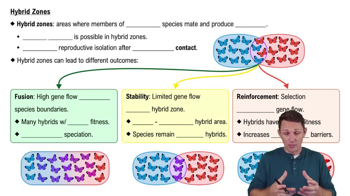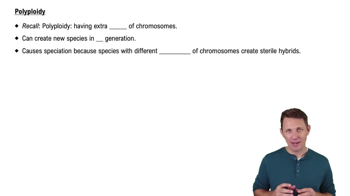If a cell were to use only 10 of the 20 possible amino acids, how much effect would you expect this to have on protein diversity? Calculate and compare the number of different sequences that can be generated by randomly assembling either 10 or 20 amino acids into peptides that are five residues long.
Table of contents
- 1. Introduction to Biology2h 42m
- 2. Chemistry3h 40m
- 3. Water1h 26m
- 4. Biomolecules2h 23m
- 5. Cell Components2h 26m
- 6. The Membrane2h 31m
- 7. Energy and Metabolism2h 0m
- 8. Respiration2h 40m
- 9. Photosynthesis2h 49m
- 10. Cell Signaling59m
- 11. Cell Division2h 47m
- 12. Meiosis2h 0m
- 13. Mendelian Genetics4h 44m
- Introduction to Mendel's Experiments7m
- Genotype vs. Phenotype17m
- Punnett Squares13m
- Mendel's Experiments26m
- Mendel's Laws18m
- Monohybrid Crosses19m
- Test Crosses14m
- Dihybrid Crosses20m
- Punnett Square Probability26m
- Incomplete Dominance vs. Codominance20m
- Epistasis7m
- Non-Mendelian Genetics12m
- Pedigrees6m
- Autosomal Inheritance21m
- Sex-Linked Inheritance43m
- X-Inactivation9m
- 14. DNA Synthesis2h 27m
- 15. Gene Expression3h 20m
- 16. Regulation of Expression3h 31m
- Introduction to Regulation of Gene Expression13m
- Prokaryotic Gene Regulation via Operons27m
- The Lac Operon21m
- Glucose's Impact on Lac Operon25m
- The Trp Operon20m
- Review of the Lac Operon & Trp Operon11m
- Introduction to Eukaryotic Gene Regulation9m
- Eukaryotic Chromatin Modifications16m
- Eukaryotic Transcriptional Control22m
- Eukaryotic Post-Transcriptional Regulation28m
- Eukaryotic Post-Translational Regulation13m
- 17. Viruses37m
- 18. Biotechnology2h 58m
- 19. Genomics17m
- 20. Development1h 5m
- 21. Evolution3h 1m
- 22. Evolution of Populations3h 53m
- 23. Speciation1h 37m
- 24. History of Life on Earth2h 6m
- 25. Phylogeny2h 31m
- 26. Prokaryotes4h 59m
- 27. Protists1h 12m
- 28. Plants1h 22m
- 29. Fungi36m
- 30. Overview of Animals34m
- 31. Invertebrates1h 2m
- 32. Vertebrates50m
- 33. Plant Anatomy1h 3m
- 34. Vascular Plant Transport1h 2m
- 35. Soil37m
- 36. Plant Reproduction47m
- 37. Plant Sensation and Response1h 9m
- 38. Animal Form and Function1h 19m
- 39. Digestive System1h 10m
- 40. Circulatory System1h 49m
- 41. Immune System1h 12m
- 42. Osmoregulation and Excretion50m
- 43. Endocrine System1h 4m
- 44. Animal Reproduction1h 2m
- 45. Nervous System1h 55m
- 46. Sensory Systems46m
- 47. Muscle Systems23m
- 48. Ecology3h 11m
- Introduction to Ecology20m
- Biogeography14m
- Earth's Climate Patterns50m
- Introduction to Terrestrial Biomes10m
- Terrestrial Biomes: Near Equator13m
- Terrestrial Biomes: Temperate Regions10m
- Terrestrial Biomes: Northern Regions15m
- Introduction to Aquatic Biomes27m
- Freshwater Aquatic Biomes14m
- Marine Aquatic Biomes13m
- 49. Animal Behavior28m
- 50. Population Ecology3h 41m
- Introduction to Population Ecology28m
- Population Sampling Methods23m
- Life History12m
- Population Demography17m
- Factors Limiting Population Growth14m
- Introduction to Population Growth Models22m
- Linear Population Growth6m
- Exponential Population Growth29m
- Logistic Population Growth32m
- r/K Selection10m
- The Human Population22m
- 51. Community Ecology2h 46m
- Introduction to Community Ecology2m
- Introduction to Community Interactions9m
- Community Interactions: Competition (-/-)38m
- Community Interactions: Exploitation (+/-)23m
- Community Interactions: Mutualism (+/+) & Commensalism (+/0)9m
- Community Structure35m
- Community Dynamics26m
- Geographic Impact on Communities21m
- 52. Ecosystems2h 36m
- 53. Conservation Biology24m
23. Speciation
Introduction to Speciation
Problem 5
Textbook Question
When the ranges of two different species meet, a stable 'hybrid zone' occupied by hybrid individuals may form. How is this possible?
a. Two diverged populations are capable of mating and producing viable and fertile offspring.
b. Hybrid individuals are always allopolyploid and are thus unable to mate with either of the original species.
c. Hybrid individuals may have reduced fitness and thus be strongly selected against.
d. One species has a selective advantage, so as hybridization continues, the other species will go extinct.
 Verified step by step guidance
Verified step by step guidance1
Understand the concept of a hybrid zone: A hybrid zone is a region where two different species meet and interbreed, producing hybrid offspring. This occurs when the ranges of the two species overlap.
Consider option a: Two diverged populations are capable of mating and producing viable and fertile offspring. This suggests that the hybrid individuals are able to survive and reproduce, maintaining the hybrid zone.
Evaluate option b: Hybrid individuals are always allopolyploid and are thus unable to mate with either of the original species. Allopolyploidy refers to having multiple sets of chromosomes from different species, which can affect the ability to reproduce with parent species.
Analyze option c: Hybrid individuals may have reduced fitness and thus be strongly selected against. Reduced fitness means hybrids might not survive or reproduce as well as purebred individuals, potentially limiting the hybrid zone.
Consider option d: One species has a selective advantage, so as hybridization continues, the other species will go extinct. This implies that hybridization could lead to the dominance of one species over the other, affecting the stability of the hybrid zone.
 Verified video answer for a similar problem:
Verified video answer for a similar problem:This video solution was recommended by our tutors as helpful for the problem above
Video duration:
39sPlay a video:
Was this helpful?
Key Concepts
Here are the essential concepts you must grasp in order to answer the question correctly.
Hybrid Zone
A hybrid zone is a geographic area where two distinct species meet and interbreed, producing hybrid offspring. These zones are often stable and can persist over time if the hybrids have some level of fitness that allows them to survive and reproduce. The stability of a hybrid zone depends on various factors, including the relative fitness of the hybrids compared to the parent species.
Recommended video:

Hybrid Zones
Hybrid Fitness
Hybrid fitness refers to the ability of hybrid individuals to survive and reproduce in their environment. In a hybrid zone, hybrids may have reduced fitness compared to their parent species, which can lead to strong selection against them. However, if hybrids possess certain advantageous traits, they may thrive, contributing to the stability of the hybrid zone.
Recommended video:

Hybrid Zones
Allopolyploidy
Allopolyploidy is a condition in which an organism contains two or more sets of chromosomes derived from different species. This can occur in hybrids, making them unable to mate with either parent species due to differences in chromosome number. While allopolyploid hybrids are often sterile, they can sometimes undergo genetic changes that restore fertility, allowing them to establish as a new species.
Recommended video:

Polyploidy

 3:03m
3:03mWatch next
Master Introduction to Speciation with a bite sized video explanation from Jason
Start learningRelated Videos
Related Practice
Textbook Question
1619
views
